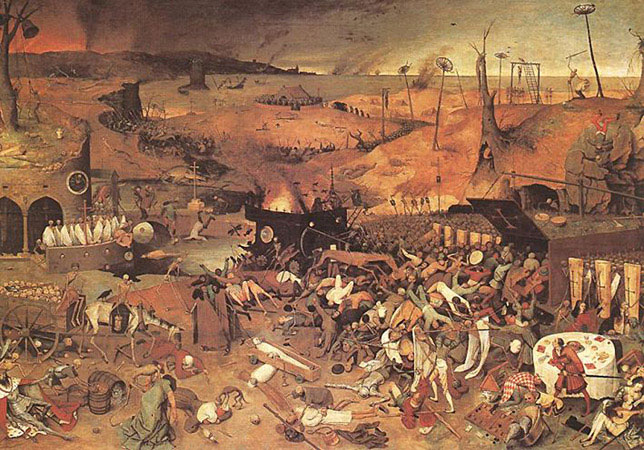

Paintings
The first major work I did using the computer in this way was based on this Breughal painting, called the Triumph of Death. Its a fairly conventional Breughal landscape, imaginatively huge with many small figures engaged in numerous different activities across the plain.
I scanned the Breughal, and then found a drawing I had done, in chinese ink, a little while before. The drawing I used had an overall baroque structure — again with activity spread across the surface, but without any sense of perspectival space. So I scanned the drawing too, and put both images together, on different layers, in Photoshop.
Combining them I got a compound image. The combination is a simple one, making the top layer partially transparent. I left out the colour, partly so that I could work with large images without overstretching the computer I had at that time.
Once I started painting, I improvised quite freely. I was happy to keep the figuration a little ambiguous. The colour remained muted, which seemed to me to suit the gravity of the subject matter.
I was pleased with this painting, so I thought Id try another in a similar way. I took another Breughal painting, called Netherlandish Proverbs. Its got an interesting structure. While elements are realistically depicted, the overall landscape is quite fanciful, more like a children's book illustration or a doll's house world. Like the Triumph of Death though, it's got lots of activity and many little subplots going on. In fact, I find some of them hilarious — its quite impossible to work out exactly WHAT the proverb actually is in most cases, and it ends up being quite surreal or Monty Pythonesque. It gave me a lot of enjoyment working with this picture.
I used this painting, called Wall, from 2001, as the background to my Breughal renovation. Its got a similar structure to the drawing I used for the painting Testimony (derived from the Triumph of Death). Its like a wall of rock or stones rising up to block off any distance. So, like my drawing for Testimony, this was somehow going to upset the perspectival space of the Breughal.
I scanned the Breughal and then chopped it up a bit, collaging backwards and forwards across the image. When I combined this with my painting image, I mixed the two images in a different way from before. I used a mask on the top image, which means that the background is blocked out until you start drawing on the mask. This way, it's like drawing with transparency. As you work, the layer below becomes visible. Its a dynamic form of collage where you have immense control over which parts end up being visible. Its even possible to reverse the process of making the mask visible, by changing the drawing colour from black to white.
Heres the final painting. This time I kept fairly accurately to the Photoshop prototype, though I altered the colour quite a bit.
Back to Dystopia. I liked this image, but it remained just a computer image, and quite photographic in quality, which isn't surprising from how it was made. I thought it could be turned into a painting so thats just what I did.
When you paint an image from a photograph, or from a computer screen image, its never going to be the same. So even though there's an element of going through the motions of painting, all the time its developing its own character, and its not quite as boring as it seems. You get a new image, but also, you can do things with painting which you can't with the computer, like stressing the surface in a subtle way so that the painting is not just a window on the world, but a real object in its own right. Also, you can change the scale of it. This painting is roughly 1.5m square, which would be challenging to do as a digital print. The scale, and the surface, are intimately related. When you look at a painting, you move around it, backwards and forwards, and as you do so, the surface becomes more, and less, apparent. The level to which the surface reminds you it is just a painting changes; it's dynamic, and ambiguous.
Next chapter: Multiple sources